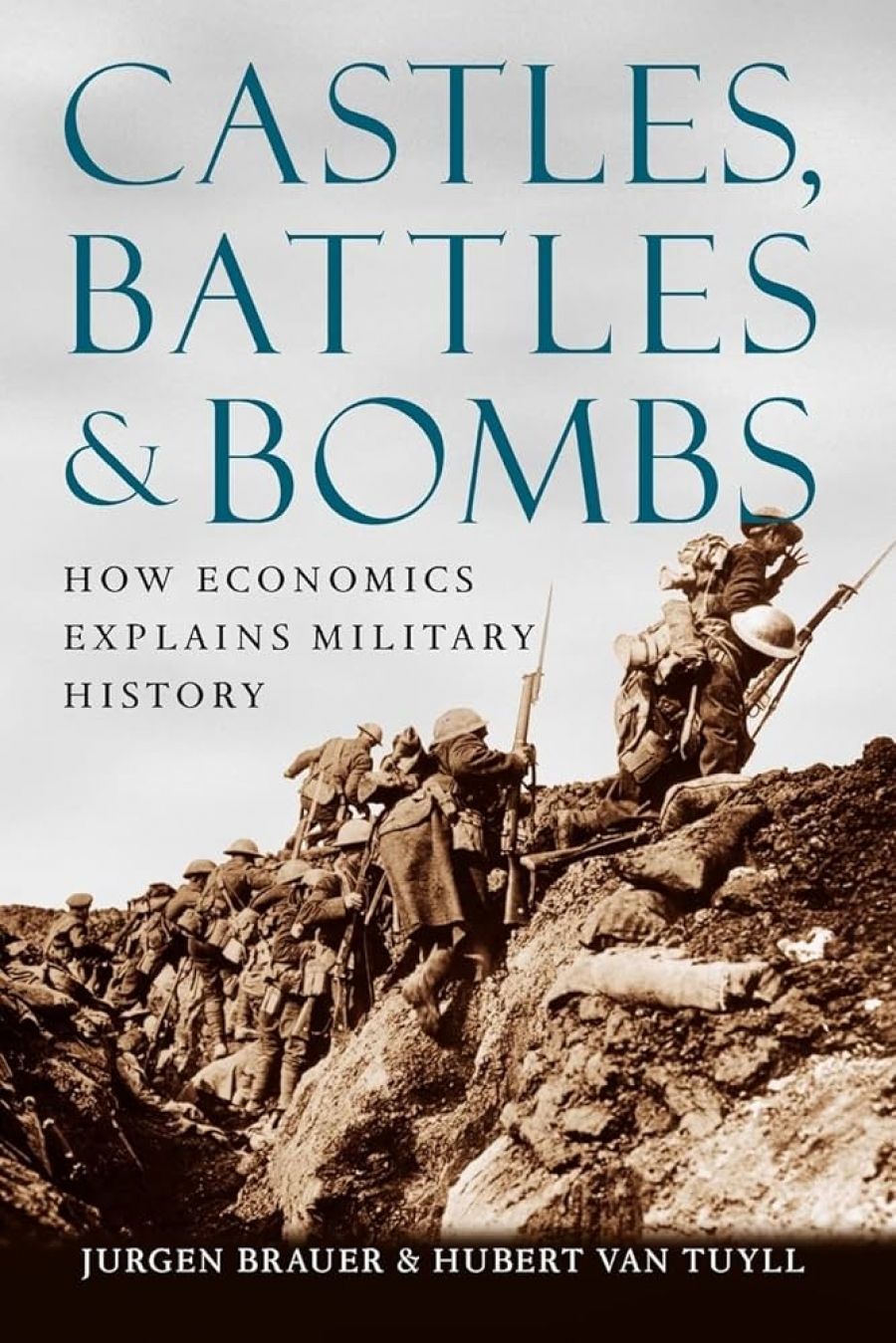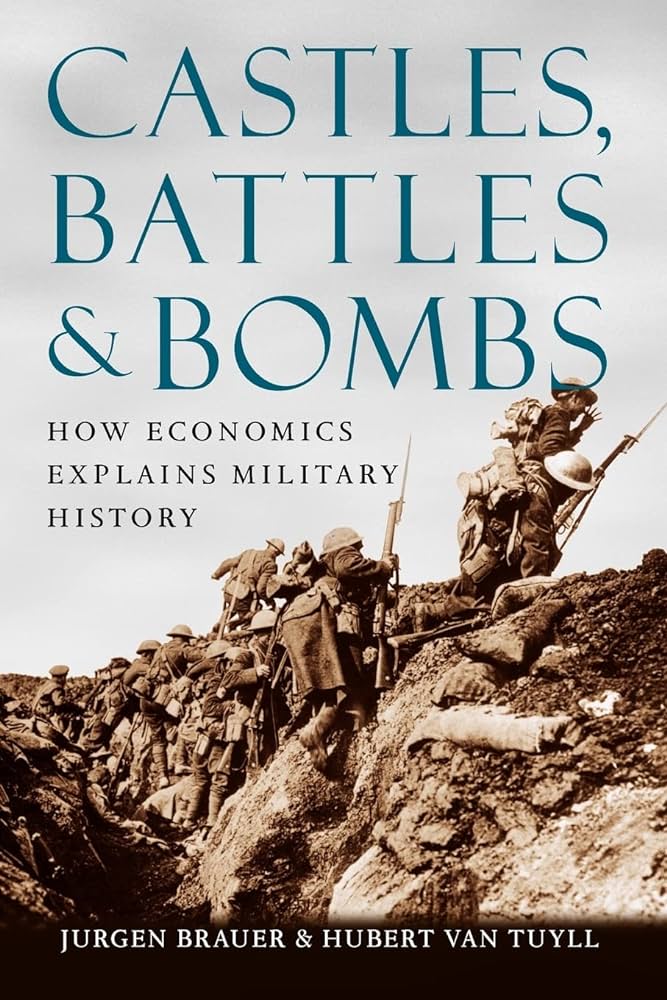
- Free Article: No
- Contents Category: Military History
- Custom Article Title: Diminishing returns
- Review Article: Yes
- Article Title: Diminishing returns
- Online Only: No
- Custom Highlight Text:
This is a book about warfare, battles and the preparations for them. It is not comprehensive but it is systematic, for it selects major periods or episodes in Western military history in the last one thousand years and, by applying economic theory, tries to pluck lessons from them. It extends from the mania for building fortified castles in medieval times to the bombing of Nazi Germany and the economics of the recent crusade against terrorism.
- Book 1 Title: Castles, Battles & Bombs
- Book 1 Subtitle: How economics explains military history
- Book 1 Biblio: University of Chicago Press, $46.95 hb, 403 pp
- Book 1 Cover Small (400 x 600):

- Book 1 Cover (800 x 1200):

Castles, Battles & Bombs offers insights about various periods of warfare. Some insights arise from the alertness of the authors, both of whom are professors at Augusta State University, but other lessons in the book probably arise from their unusual technique. As economics is perhaps the most advanced of the social sciences, and as it is not frightened of making bold generalisations about human behaviour, some of its theories, the authors imply, should be applicable to military behaviour. Accordingly, they select six important episodes in warfare, five in western Europe and one in the United States, and then found a well-known economic theory or tool which might help to illuminate each episode.
In studying medieval warfare, and its emphasis on building defensive castles rather than equipping large armies, the authors invoke the principle of ‘opportunity cost’. They point out that the castle had special advantages. It was a cheap way of guarding and controlling conquered enemy territory. Moreover, in an era of defensive warfare, a small force of men could defend it for a long period against a large army waiting outside the ditches and walls. In an era of more offensive warfare, however, a castle had a huge defect. It was static. It was like a modern armoured division that could not move.
The above is my quick summary of a rather fuller set of arguments, including the high cost of financing even a tiny permanent army in medieval times. But the centuries passed, population expanded, and by the time of Napoleon the French economy was strong enough to release huge numbers of men for the task of full-time fighting. Napoleon, unlike Frederick the Great, could tolerate massive casualties. His bold tactics also invited them.
The chapter on the American Civil War points to the new role which information played in warfare. This was the first big war in which the new telegraph, railway and newspaper were used to disseminate information, both true and false. But even these new media could not easily delete the home-ground advantage. A defender knew his own terrain. Therefore he usually won the information contest. That advantage was almost enough for the South to hold out against the Union’s ‘overwhelming advantage’ in troops and war materials. Of course, some generals were smarter than others. General Robert E. Lee of the South had the gift of predicting what his opponent was likely to think and do. But General Ulysses S. Grant finally caught up.
It seems to me that economic theory in itself does not provide Brauer and van Tuyll with dramatic results. But it compels them to ask penetrating questions about the past, and even to notice and challenge their own assumptions.
Some chapters end by posing questions to the reader. For example, the Union army conscripted soldiers one hundred years before the same practice in the Vietnam War created a political storm. In the Civil War, the young Americans conscripted to Grant’s side could easily disappear, or buy their way out with a commutation fee, or pay somebody else to take their place. A long endnote, buried in page 352, reveals the astonishing fact that of the 777,000 potential soldiers whose ‘draft numbers’ were called, only 46,000 were actually drafted into the Union army. A big number paid other young men a bounty to take their place. Did this – the authors ask – ‘prolong the conflict in that the fees were used to induce less able men to sign up for service?’
The heavy British bombing of German cities in World War II persuaded the authors to consult another economic theory: ‘diminishing marginal returns.’ In the face of massive air raids, German railways and factories were surprisingly resilient, and Germany continued to make more and more aircraft. Moreover, contrary to predictions, the bombs did not weaken the German civilian morale, just as the earlier German bombing of London had not dinted British morale. Nonetheless, decisions in the air war were crucial, especially Hitler’s decision to produce attacking bombers rather than defending fighter-aircraft, which was to impair his ability to resist invasion. Ultimately, the grave scarcity in his régime proved to be inexperienced pilots rather than planes.
The pages on terrorism, added as an afterthought (the book was planned before 9/11), highlight the role of the media. Newspapers in England and France were first an influential player in the Crimean War in the 1850s. During the recent wave of extreme-Islam terrorism, the media became decisive participants in warfare. The fact is that terrorists have a powerful, if half-reluctant ally, in the free press. They need reportage. Without it, their actions cannot spread fear or terror. This book argues that few terrorist attacks actually occur ‘in countries where the media are state-controlled’.
Some pages will not convince readers. Many will be surprised to read the verdict that World War I produced massive slaughter but no real victory for the winning side. Surely, however, it was a real and decisive military victory. Otherwise, such harsh peace terms could not have been imposed on Germany by France, Britain, America, Australia and the other victors at Versailles and Paris in 1919. What later happened was that the victory was thrown away by the world Depression, by the withdrawal of the United States from world affairs and by the victors’ astonishing refusal to prevent Hitler from rearming Germany in the mid 1930s. The same terrible mistake was not repeated by the victors during the three decades after the end of World War II.
My feeling is that the authors, well informed about war, do not yet have a theory of what causes peace. But one day it might well come to be recognised, in methodological terms, that the causes of war can’t be understood without understanding the causes of peace.
Castles, Battles & Bombs is bold and challenging. Some general readers may find it heavy-going here and there, but students of military history will find stimulus in the questions it answers and asks.


Comments powered by CComment